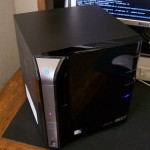Acer H340 NAS

Edit 12/15/2014: Ooops: the Atom Z230 is a hyper-threading single-core CPU, not a dual-core. I noticed this a few months ago but haven’t gotten around to updating this post until now.
Several months ago, a friend gave me an Acer Aspire easyStore H340 NAS. The system hard drive had failed and up until recently I haven’t had any spare SATA drives, so it collected dust on top of my desktop computer until I could find a drive for it.
The stock H340 has the following:
- 1.6GHz Intel Atom 64-bit dual-core CPU
- 2GB DDR2 RAM
- 4x SATA 2.0 hard drive bays
- 1TB Western Digital Caviar Green hard drive
- 1x Gigabit Ethernet port (Marvell chipset)
- 5 USB 2.0 ports
- 1 eSata port
- 1 PCI-E 1x connector (not used).
- Windows Home Server
- Onboard 256M flash device containing restore image for the OS (although it seems to need a driver/application DVD as well).
All in all, a capable little device, especially for the low, low price of free. It sits in a case approximately 10″ square. Air is drawn in from the left side, across the hard drive bays and over the motherboard at the bottom of the case, and exhausted out the right side by a 120mm fan. Notably, there is no video connector–which makes sense, considering it’s marketed as a headless NAS. Still, this is limiting, although there are several companies who make VGA/PS2 dongles that connect to a proprietary connector, and the PCI-E slot could be used for a PCI-E 1x video card.
Lacking the WHS restore disk, I decided to put Ubuntu Server on the H340. First, I did a little research to find out if this device will boot from a USB flash drive. It will, but not by default; the jumper JP3 on the motherboard puts the NAS into “debug” mode, which allows you to change the boot order in the BIOS–except I couldn’t see the BIOS, because there’s no video card connector. Ooops. So I went with the considerably less exciting route and installed Ubuntu Server on another computer, then transferred the hard drive to the NAS.
With JP3 jumpered (in debug mode), the device seemed to ignore the hard drive and booted into some sort of rescue/recovering environment with a hostname containing “minint”. I suspect this is what is contained on the onboard 256M flash device. Once I removed the jumper on JP3, restoring the NAS to stock configuration, it booted right up. I installed Samba and several minutes later had a simple file server set up and running.
Some thoughts:
- If you set up Ubuntu Server on a second computer, you’ll want to remove the entry in /etc/udev/rules.d/70-persistent-net.rules such that the NIC in the NAS (there’s some alliteration for you) will be detected as eth0 and not, say, eth1. You’ll also want to have OpenSSH set up so you can SSH into it after installing the hard drive.
- You’ll probably want to install lm-sensors and smartmontools to keep an eye on temperature and hard drive health. I also installed logwatch and configured it to email my LAN’s mailserver.
- The power supply fan (a tiny 40mm fan on the back of the proprietary power supply) is noisy. I suspect this is specific to my used H340 and not common to all H340s.
- The side fan is reasonably quiet. However, once it boots, the motherboard throttles the fan down to 700RPM. CPU temperature idles around 63-65C in this configuration. The fan speed can be adjusted either manually or via a script (such as fancontrol). I have mine set to about 1100RPM, which lowers CPU temperature by 4-6C while keeping the room quiet enough for me to sleep at night. It also helps cool the hard drive(s)–and cooler hard drives tend to be less troublesome.
- The hard drive LEDs and the “i” front panel LED need a driver to control them. Fortunately, someone has written one called mediasmartserverd. Among other things, it enables the drive lights and allows you to control the brightness of all the LEDs–useful for sleeping in a dark room. It also allows you to control the “i” LED and use it as an indicator when operating system updates are available. (This feature may be Ubuntu/Debian specific.) The color scheme is as follows: blue == updates available, purple == security updates available, red == reboot needed (after updates are applied). Note that it is godawful hard to differentiate between purple and red when the brightness is turned down low; the purple looks very much like red.
- The H340 is adorable. I like the form factor.
To control the fan and start mediasmartserverd, I put the following in my /etc/rc.local, just above the “exit 0” line:
# warning: I don't really know what this is doing # put the fan into user-controlled mode (?) default is "2" echo 1 > /sys/devices/platform/dme1737.2160/pwm1_enable # allow root to adjust the fan speed chmod u+w /sys/devices/platform/dme1737.2160/pwm1 # echo a value between ~100 and 255 here. # corresponds (somewhat) to fan speed # If it's too low, your drives/CPU may fry! echo 130 > /sys/devices/platform/dme1737.2160/pwm1 # start mediaserverd, adjusting LED brightness and update checks /usr/local/bin/mediasmartserverd --brightness 3 --update-monitor -D
Remember, overriding the motherboard’s fan control is risky. I’m making it run faster than it does by default, but a typo could cause it to run slower or not run at all. Be careful. You don’t want to fry your hard drives!
All in all, I’m pleased with this little device. It’s not the fastest server in the world, but it’ll get the job done, and for me, that’s all that matters.
It’s also cute. Just pointing that out…
